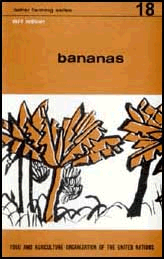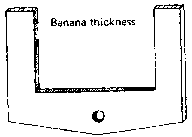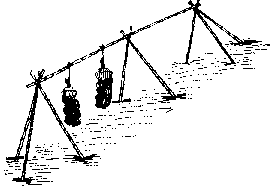
Harvesting and use of bananas[edit | edit source]
Harvesting[edit | edit source]
Bananas must not ripen on the plant.
The bunch of fruits finishes ripening tied to a rope, in the shade.
If the bunch ripens on the plant, the bananas split and become mealy.
Bunches can be kept longer if they are harvested unripe.
Output of a plantation[edit | edit source]
A well- cared- for plantation has a big output.
The third harvest on any one plantation is the biggest, of all.
From the fourth harvest, the output begins to go down.
The yield of a plantation may vary between 30 and 50 tons per hectare.
Use of bananas[edit | edit source]
Bananas are a strength- giving food.
The sweet banana, eaten raw when it is ripe, is as rich as other raw fruits.
It contains a lot of vitamins.
It should be eaten very ripe.
Plantains, when prepared, give more energy than prepared cassava.
They contain more protein (see Booklet No. 8, page 14) than cassava, but less mineral salts (see Booklet No. 1, page 19).
It is better to eat plantains than cassava.
Food crop bananas such as plantains and certain fig bananas are eaten cooked. The greener they are when harvested, the less sweet they are.
Large quantities of plantains are eaten in all the forest regions of west Africa. Ivory Coast produces about 1 100 000 tons of plantains, Cameroon about 850 000 tons, and Gabon about 80 000 tons.
- Cooked bananas
To make foutou, peel plantains, cook them in water, then mash them and roll them into balls.
Plantains are also eaten grilled over the fire, or fried in oil.
- Dried bananas
- Bananas can be dried, if you cannot sell them all. Peel them, then slice them into rounds and dry them in the sun. When they are dry they can be made into powder or flour.
- Banana flour is made with plantains or with green fig bananas. It is eaten in forest regions.
- Banana powder is sweet. It is made from ripe bananas. Mash the bananas and dry the paste in the oven. Banana powder should be stored in metal boxes and kept in a dry place.
- Making banana beer
The bananas must be very ripe.
In the rainy season let them finish ripening laid on a hurdle over the fire where the cooking is done.
During the dry season make a pit in the ground. On one side of it, dig a little ditch. Cover all the sides of the pit with green banana leaves. Pack the bunches of bananas in the pit. Cover them with banana leaves and earth. Light a fire in the ditch and let the warmth and smoke into the pit.
Keep the fire going every day until the bananas are quite ripe. This takes about six days.
Then take away the leaves and earth. Peel the bananas. Half- fill a hollowed- out tree trunk with banana pulp. Cover with fine grass. Knead the pulp with a little water. Press it and let the juice run out.
Then put the juice in a vat or earthenware jar with germinated millet and a little beer.
Cover the vat or the jar with grass to act as a filter.
The beer can be drunk the next day through a straw or wooden tube.
This beer will not keep for very long.
Banana beer is made chiefly in Rwanda and Burundi with special varieties of bananas.
- Other uses of the banana plant
Bananas can be given to animals to eat especially to pigs.
The skins and the male flower buds can also be used as fodder.
Oxen like the chopped- up apparent trunk and leaves mixed with oil cake.
If you leave the remains of the plants (such as apparent trunk, leaves, flower buds) on the ground of the plantation, they will become organic matter in the soil.
If you take these remains away from the plantation to give to animals, you will not add organic matter to the soil. But a banana plantation needs plenty of organic matter. So if you remove the banana plant remains, you must give the plantation dried herbage, manure or compost.
Banana leaves contain fibre. Sacks and ropes are made with this fibre.
It is obtained chiefly from a variety of banana called abaca.
The fibres of abaca leaves are called "Manila hemp."
Running a commercial banana plantation[edit | edit source]
This example of a commercial banana plantation comes from near Akoup� in southern Ivory Coast:
Every day, new flowers appear on the plants.
On the 5th and 20th of each month, the new flowers are counted. They are marked with a little button tied on with wire.
Buttons of a different color are used each time the flowers are counted.
In this way, the number of new flowers is known. In about 3 months these new flowers will yield a bunch of bananas for harvesting.
The planter knows the number of bunches that will ripen and can arrange for transport by banana boat.
A banana boat comes about twice a week. Each time a little of the harvest is sent
It works like this: Suppose the planter has ordered transport for 40 tons of fruit during the month.
Then he sees that the fruit will ripen before the 15th of the month. He asks for transport for 25 tons during the first 2 weeks of the month, leaving 15 tons for the rest of the month.
All the plantation owners belong to a cooperative, COFRUCI (Compagnie fruiti�re de C�te d'lvoire). It organizes transport in banana boats.
Bananas must be graded by size. In the plantation they use an instrument called a gauge to measure the thickness of bananas.
A gauge
Bananas are graded from 40 to 45 millimetres thickness There are two grading systems, one with the odd numbers (41, 43 or 45 millimetres) and the other with the even numbers (40, 42 or 44 millimetres)
When the planter gives his orders for the shipment he can state which system he wants
For grading, three bananas in one hand are chosen and each is measured.
The thickness of the bananas on a bunch is related to the number of hands on the bunch.
If the bunch has 5 to 7 hands, the size of the three bananas measured should be 40 or 41 millimetres, depending on the chosen grading system. If the bunch has 7 to 10 hands, the size of each of the three bananas measured should be 42 or 43 millimetres. If a bunch has more than 10 hands, the size of each of the three bananas should be 44 or 45 millimetres.
The bunches ready for harvesting are known by the color of the buttons with which the bunches were marked 3 months earlier.
The planter says what size fruit he wants picked.
A worker goes through the plantation and counts the number of hands on each bunch with a button of the right color, measures three bananas on each of the bunches, makes sure that the bunch is ready for harvesting, and marks the bunch for cutting.
The bunches are cut early in the morning.
This is done one day, at most, before the boat leaves.
Men carry the bunches out of the plantation on a pad on their backs.
The bunches are tied to long poles supported by trestles. The string used for tying is soaked in copper sulphate.
Support for bunches
The bunches are weighed.
The colored buttons are taken off the bunches.
The buttons of one color, let us say green, are then counted.
Three months earlier, 1 600 green buttons were fixed to the plants in the plantation.
Now, for example, 360 green buttons are counted.
So the planter knows that he still has 1240 bunches marked green (1600 less 360).
These bunches marked with the green buttons will ripen in the course of the month.
Transporting and packing bananas
The goods lorry arrives.
Inside, it has pads along the sides to protect the bunches.
On the floor of the lorry there is a thick layer of dry leaves.
Each bunch is wrapped and a cover is put over each row of bunches.
The lorry drives to the packing station.
There, the size of the bananas is measured again.
All the bunches which do not measure up to the required size are thrown out
Stained or rotten bunches are also rejected.
The bunches are cut info hands of bananas and these hands are cleaned and washed.
The hands of bananas are packed in cartons.
Some countries still send out complete bunches, but this wastes a lot of space and weight.
The cartons are then taken to the banana boat.

